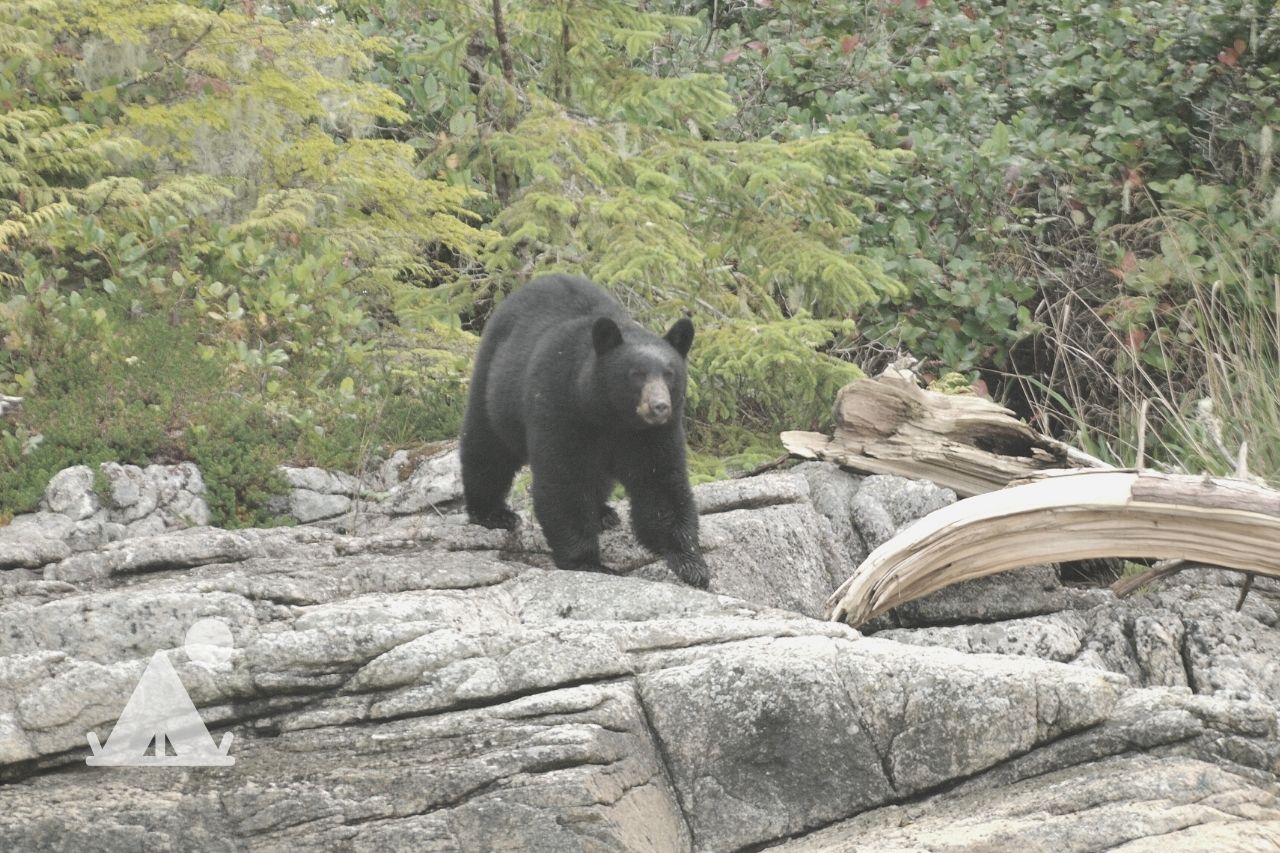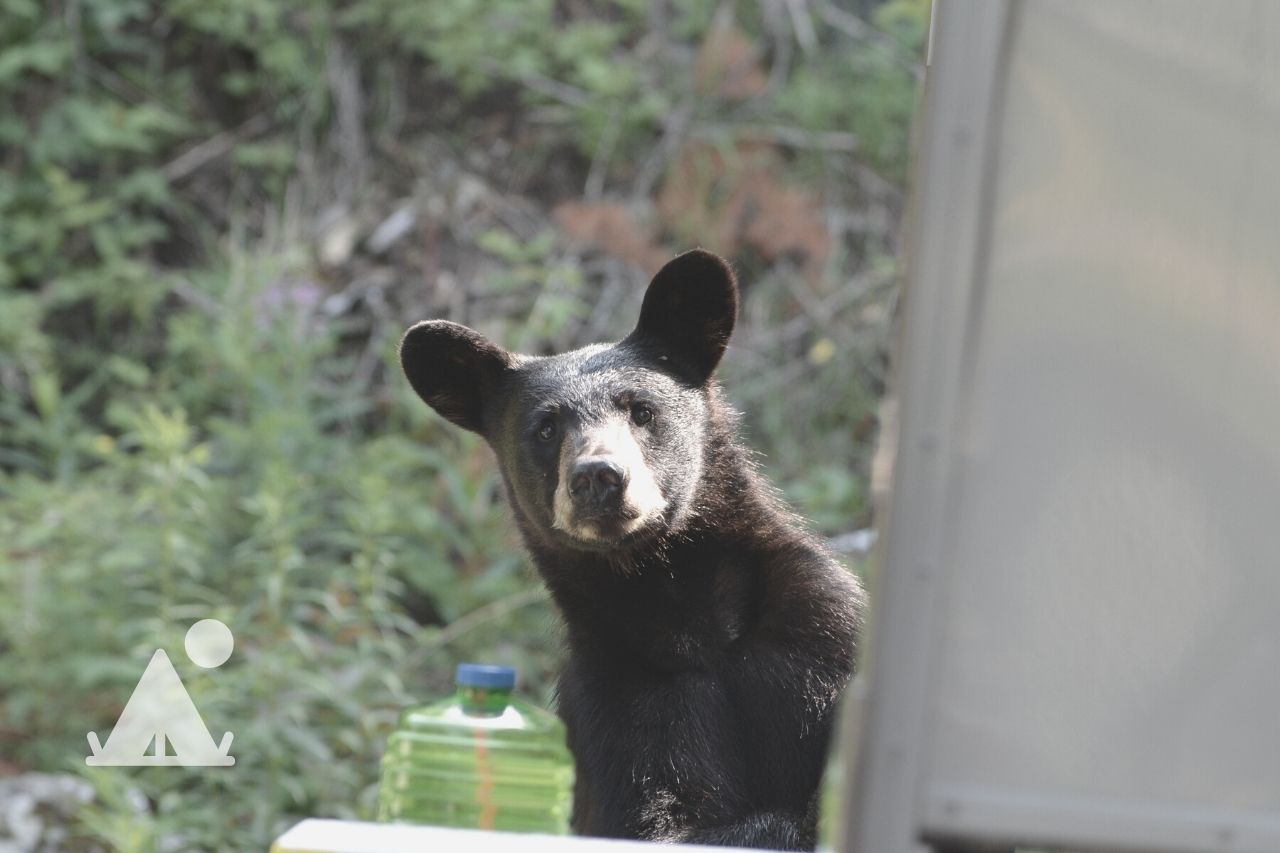Bear sightings in the wild usually turn out okay. Bears, like most wild animals, prefer to keep their distance from humans and can be often intimidated away.
That said, bears are wild and unpredictable. Knowing what to do can save your life. Here’s a guide on what to do if you see a bear while hiking, and how to avoid meeting a bear in the first place.
Are Bears Dangerous To Humans?

Bears are big and heavy, and could easily take down a human. And because they are wild animals, they are unpredictable.
So, yes, all bears are dangerous to humans.
But they are not all equally dangerous. How dangerous a bear is depends on the type of bear (black, brown, or polar), how hungry it is, and how threatened it feels.
When going outdoors, whether hiking or camping, always assume all bears are dangerous and could hurt you.
Take all the precautions you can and, most importantly, be ready to act if you see a bear.
Being careful is not just important for your safety. It also protects the bear. Bears that attack humans are at risk of being euthanized by park officials.
Which Is The Most Dangerous Type of Bear?
There are three species of bears in North America: black bears, brown bears (which include the grizzly subspecies), and polar bears.
- Black bears – These are the least dangerous. They’ll stay away from humans and can be easily scared away. You can recognize a black bear by its straight shoulders (no hump), pointy ears, and a straight sloping face.
- Brown bears/grizzlies – Grizzlies are bigger and more aggressive than black bears, and thus are more dangerous. You can identify a brown bear by the hump on its shoulder, rounded ears, curved face profile, and its bigger body.
- Polar bears – Polar bears usually appear white. Unless you are hiking in Alaska or some parts of Canada, you’ll not encounter a polar bear in the mainland US. Polar bears are the most dangerous types of bears and they are not easy to scare away.
What To Do If You See a Bear While Hiking?
Even when hiking in bear country, you’ll be lucky to spot a bear. They are hard to come across, partly because they are most active early in the morning and late in the evening.
So you normally don’t need to worry about encountering a bear.
But even if you come across a bear, you don’t need to do anything if it is far away. You can stop and view the bear, but stay at least 200 feet away from it.
However, if the bear is close and has noticed you, you need to be careful what you do next. Appear as friendly and harmless as possible instead of being a threat. And if that fails, intimidate the bear.
Here are some specific tips on what to do if you see a bear while hiking.
- If it’s far away and has not noticed you, keep going but keep an eye on it just in case it changes its behavior.
- If the bear is close and has noticed you, stand still and look straight at it. Wave your arms slowly to make sure the bear recognizes you as human (bears typically don’t see humans as prey).
- Do not bend or crouch as the bear could see you as an animal and attack you. If you have a pet or a child, pick them up immediately.
- Talk calmly to the bear. As long as the bear is stationary, do not scream or shout as the bear may perceive that as a threat.
- While maintaining eye contact, slowly walk backwards or sideways away from the bear. Sideways is usually better as you are less likely to trip.
- Make sure you don’t get between a mother bear and her cubs. A bear protecting her cubs will quickly attack any perceived threat.
- Keep bear spray in your hand and be ready to use it if the bear comes close.
- Whatever you do, never run from a bear even when it’s approaching you. It’ll trigger the natural chase instinct in a bear, and there’s no way you are going to outrun a bear.
The most important thing to do when you see a bear is to stay calm. Usually, bears just want their space and will not attack you unless they feel threatened.
Here’s a helpful video from REI summarizing what to do if you encounter a bear.
What To Do If a Black Bear Approaches You When Hiking?
Black bears are the least aggressive types of bears. If a black bear starts walking towards you, it’s probably just curious and investigating whether you are a threat.
Stand your ground and stay calm while talking to it in a normal human voice. Do not shriek, whistle or imitate an animal sound.
Keep bear spray in your hand, ready to use if the bear gets to within 30 feet of your position.
If the bear keeps approaching, switch to intimidation tactics. Make yourself look big and make as much noise as you can by shouting it at.
You can also throw sticks and stones at it. Unless its cubs are in danger, black bears will usually walk away rather than engage in a conflict.
If the bear gets too close or charges you, use the bear spray to try and divert it.
If you don’t have bear spray or it doesn’t work on the bear, time to fight for your life. Protect your neck and head while hitting the bear on its eyes, nose and other tender areas.
Keep shouting and be as aggressive as possible.
By the way, don’t try to climb a tree to get away from a black bear. They are excellent climbers.
What To Do If a Brown Bear Approaches You When Hiking
Keep calm and don’t run when a grizzly bear starts approaching you. Talk to the bear and maintain eye contact.
If the bear stops, walk backwards or sideways away from it. If the bear starts walking towards you again, stop and hold bear spray ready.
If the bear gets too close, use bear spray. It’s the best defense against a grizzly attack.
If you don’t have bear spray or it doesn’t work on the bear, the next best option is to play dead. Lie on your stomach and place your hands over your neck to protect your spine.
Stay calm and hope the bear no longer sees you as a threat and walks away. Keep still for at least 20 minutes until you are sure the grizzly is gone.
Do not attempt to fight a grizzly. You’ll almost definitely lose the fight. An adult male grizzly can weigh over 700lbs.
What To Do If a Polar Bear Approaches You When Hiking?
Despite popular belief, polar bears do not hunt down humans.
Polar bear attacks are usually by young and starving bears, or mother bears protecting their cubs.
So the same ‘stay calm, talk to the bear, and maintain eye contact’ actions that work with grizzlies and black bears can also be effective with a polar bear.
But if you are unlucky and come across a hungry polar bear, you don’t have many options.
A hungry polar bear is dangerous and will immediately see you as prey. Intimidation doesn’t work on polar bears, nor does playing dead.
If a polar bear charges you, your best protection is bear spray. If that fails, fight as hard as you can.
The good news is that most Americans will never encounter a polar bear in the US as they are only found in Alaska.
How to Avoid A Bear Attack?

Your best protection when hiking in bear countries is to avoid a bear encounter in the first place.
Here are some ways to do that.
- Hike in a group. Bears are less likely to approach or attack a group of people. The loudness and stronger smell of a large group also warns bears of human presence from far off, giving them time to walk away.
- In places with known bear sightings or where bears are likely to be, make noise by talking, singing or wearing bear bells. This will keep you from surprising a bear, which can trigger an attack. If a bear knows you are coming, you’ll be safer.
- Avoid hiking in bear country with pets as they can provoke the bear to attack.
- Carry any food and scented items with you in an odor proof bag to ensure they don’t attract bears. If you are using a bear canister, place food in odor proof bags first since a bear canister on its own doesn’t keep a bear from smelling food.
- Stick to marked trails and paths, ideally those that are heavily used. Bears will usually stay away from where humans often are.
Can I Use a Firearm To Prevent a Bear Attack?
Parks don’t allow the use of firearms within their boundaries.
In any case, a gun is not the best defense against an attacking bear, according to the National Park Service.
A gun is more likely to wound rather than kill a bear and a wounded bear is even more dangerous.
And even if you kill the bear, that’s not ideal for the bear. Bear spray is the best weapon. It’s highly effective, anyone can use it, and it protects both you and the bear.